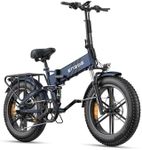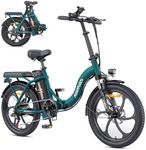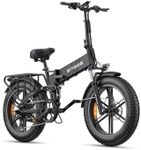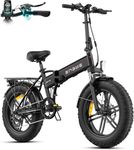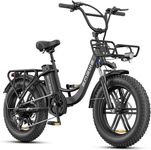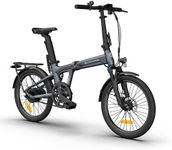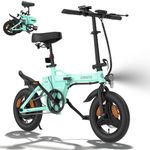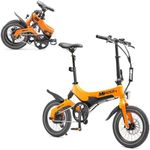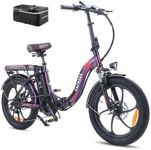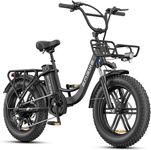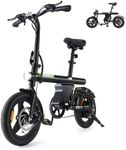Buying Guide for the Best Folding Electric Bikes
Folding electric bikes are a great option for those who need a compact, portable, and eco-friendly mode of transportation. They are perfect for city dwellers, commuters, and anyone with limited storage space. When choosing a folding electric bike, it's important to consider several key specifications to ensure you get the best fit for your needs. Here are the main specs to look at and how to navigate them.Battery LifeBattery life determines how far you can travel on a single charge. This is crucial for planning your trips and ensuring you don't run out of power mid-journey. Battery life is usually measured in watt-hours (Wh) or amp-hours (Ah). Higher values mean longer distances. If you have a long commute or plan to use the bike for extended trips, look for a battery with higher capacity. For shorter, occasional rides, a lower capacity battery may suffice.
Motor PowerMotor power, measured in watts (W), affects the bike's speed and ability to handle inclines. More powerful motors provide better performance but may also consume more battery. Motors typically range from 250W to 750W. If you need to tackle steep hills or want faster acceleration, opt for a higher wattage motor. For flat terrains and leisurely rides, a lower wattage motor will be adequate.
WeightThe weight of the bike is important for portability and ease of use. Lighter bikes are easier to carry and fold, making them ideal for those who need to transport the bike frequently or have limited strength. Folding electric bikes can range from around 30 pounds to over 60 pounds. Consider how often you'll need to carry the bike and choose a weight that you can manage comfortably.
Folded SizeThe folded size of the bike determines how compact it is when not in use. This is crucial for storage and transportation, especially if you have limited space at home or need to fit the bike in a car trunk or public transport. Check the dimensions of the bike when folded and ensure it fits your storage requirements. Smaller folded sizes are better for tight spaces.
Frame MaterialThe frame material affects the bike's durability, weight, and ride quality. Common materials include aluminum, steel, and carbon fiber. Aluminum is lightweight and resistant to rust, making it a popular choice. Steel is heavier but more durable and can absorb shocks better. Carbon fiber is the lightest and strongest but also the most expensive. Choose a frame material based on your priorities for weight, durability, and budget.
Wheel SizeWheel size impacts the bike's stability, comfort, and ability to handle different terrains. Folding electric bikes typically have smaller wheels, ranging from 16 to 20 inches, to maintain a compact size. Smaller wheels are more maneuverable and easier to store, while larger wheels offer a smoother ride and better performance on rough surfaces. Consider where you'll be riding most often and choose a wheel size that matches those conditions.
RangeThe range is the maximum distance the bike can travel on a single charge. This is influenced by factors like battery capacity, motor efficiency, rider weight, and terrain. A longer range is beneficial for longer commutes and trips. If you plan to use the bike for short, frequent rides, a shorter range may be sufficient. Always check the manufacturer's range estimates and consider your typical usage patterns.
Assist LevelsAssist levels refer to the different levels of motor assistance available on the bike. More assist levels provide greater flexibility in how much help you get from the motor. Commonly, bikes offer 3 to 5 assist levels. Higher assist levels make pedaling easier but drain the battery faster. If you want more control over your riding experience and battery usage, look for a bike with multiple assist levels.
